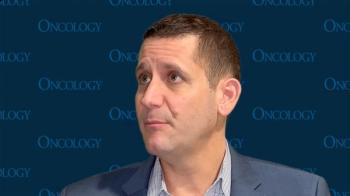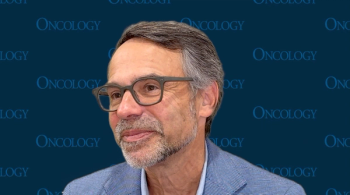
Quizartinib Added to Chemo Boosts Overall Survival in FLT3-ITD–positive AML
The combination of quizartinib plus chemotherapy yielded better survival outcomes vs chemotherapy alone in the frontline setting of FLT3-ITD-positive acute myeloid leukemia.
In patients with previously untreated FLT3-ITD mutation–positive acute myeloid leukemia (AML), quizartinib added to induction and consolidation with standard chemotherapy and then administered as a single agent resulted in superior overall survival (OS) vs matched chemotherapy, according to results of the phase 3 QuANTUM-First trial (NCT02668653) that were presented at the
At a median follow-up of 39.2 months, primary analysis for OS revealed a doubling of the median with quizartinib vs placebo at 31.9 months (95% CI, 21.0-not estimable; NE) and 15.1 months (95% CI, 13.2-26.2), respectively (HR, 0.776; 95% CI, 0.615-0.979; 2-sided P = .0324).
“The QuANTUM-First results show that adding quizartinib to standard chemotherapy significantly improved overall survival in patients with newly diagnosed FLT3-ITD-positive acute myeloid leukemia,” Harry P. Erba, MD, PhD, instructor in the Department of Medicine, Division of Hematologic Malignancies and Cellular Therapy of Duke Cancer Institute, said in a news release. “There is great interest in the increased use of targeted therapies to improve outcomes for patients with AML, particularly those with the FLT3-ITD subtype, which is one of the most common, aggressive and difficult-to-treat.”
The study examined patients ages 18 to 75 years who presented with newly diagnosed primary or secondary AML harboring a FLT3-ITD activating mutation with an allelic ratio of 3% or greater FLT3-ITD/total FLT3 who were randomized 1:1 to chemotherapy with cytarabine and daunorubicin or idarubicin plus either quizartinib (n = 268) or matched placebo (n = 271). Induction involves up to 2 cycles of chemotherapy followed by active therapy or placebo, consolidation with up to 4 cycles of cytarabine followed by quizartinib or placebo and/or hematopoietic stem cell transplant, and up to 36 cycles of additional active therapy or placebo.
The primary end point is OS, with secondary measures of event-free survival (EFS), rate of complete remission (CR), CR composite (CRc) rate at the end of induction, safety, and pharmacokinetics.
Analysis of EFS did not yield a statistically significant benefit in either arm, with a hazard ratio of 0.916 (95% CI, 0.754-1.114; P = .2371). After controlling for patients with induction treatment failure defined as not achieving CR by day 42 of the last cycle of induction, the hazard ratio was 0.818 (95% CI, 0.669-0.999; P = .0323).
Rates of CR in the quizartinib and placebo groups were 54.9% (95% CI, 48.7%-60.9%) and 55.4% (95% CI, 49.2%-61.4%), respectively; corresponding rates of CRc were 71.6% (95% CI, 65.8%-77.0%) and 64.9% (95% CI, 58.9%-70.6%). CR with incomplete hematologic recovery occurred in 16.8% (95% CI, 12.5%-21.8%) of patients treated with quizartinib and 9.6% (95% CI, 6.4%-13.7%) of those who received placebo. Duration of CR was 38.6 months (95% CI, 21.9-NE) with quizartinib vs 12.4 months (95% CI, 8.8-22.7) with placebo. Relapse-free survival in those who achieved CR was 39.3 months and 13.6 months, respectively (HR, 0.613; 95% CI, 0.444-0.845).
No new safety signals were reported with the combination of quizartinib plus chemotherapy followed by single-agent quizartinib. The rate of grade 3 treatment-emergent adverse events (TEAEs) was similar between arms, with the exception of grade 3 neutropenia at 18.1% with the experimental regimen vs 8.6% with the control. Other grade 3 TEAEs occurring in both groups were febrile neutropenia (43.4% vs 41.0%, respectively), hypokalemia (18.9% vs 16.4%), and pneumonia (11.7% vs 12.7%).
Of note, QTcF prolongation was more common with quizartinib, with 2.3% experiencing this event and 0.8% discontinuing treatment, but ventricular arrhythmia events were uncommon. Two patients (0.8%) suffered cardiac arrest with recorded ventricular fibrillation on ECG, both with severe hypokalemia; 1 patient died as a result.
“We are proud that another one of our medicines has demonstrated a significant survival advantage, as our goal is to leverage innovative science to change the way cancer is treated,” Ken Takeshita, MD, Global Head of R&D at Daiichi Sankyo, said in a news release. “Adding targeted treatment with quizartinib, a potent and selective FLT3 inhibitor, to standard chemotherapy resulted in a doubling of median overall survival in patients with newly diagnosed FLT3-ITD–positive acute myeloid leukemia compared to standard chemotherapy alone. Based on these positive QuANTUM-First results, we have initiated global regulatory filings in order to bring quizartinib to patients as quickly as possible.”
References
- Erba H, Montesinos P, Vrhovac R, et al. Quizartinib prolongs survival vs placebo plus intensive induction and consolidation therapy followed by single-agent continuation in patients aged 18-75 years with newly diagnosed FLT3-ITD+ AML. Presented at: 2022 EHA Congress; June 9-12, 2022; Vienna, Austria. Abstract S100.
- Quizartinib plus chemotherapy significantly improved overall survival compared to chemotherapy in patients with newly diagnosed FLT3-ITD positive acute myeloid leukemia. News release. Daiichi Sankyo. June 11, 2022. Accessed June 13, 2022. https://yhoo.it/3NLYIW0
Newsletter
Stay up to date on recent advances in the multidisciplinary approach to cancer.
















































































